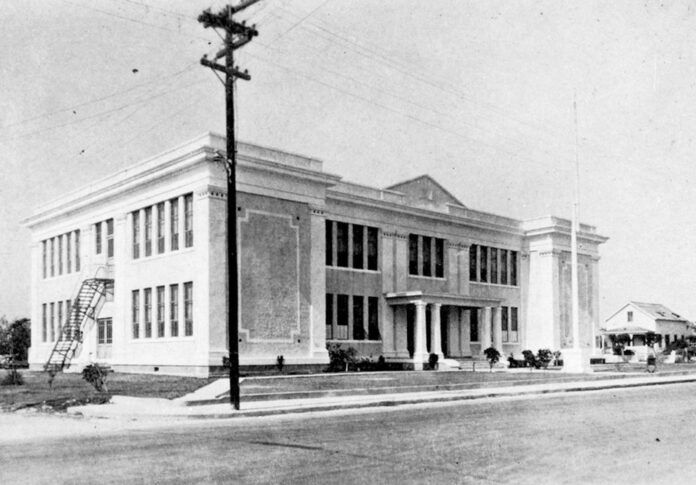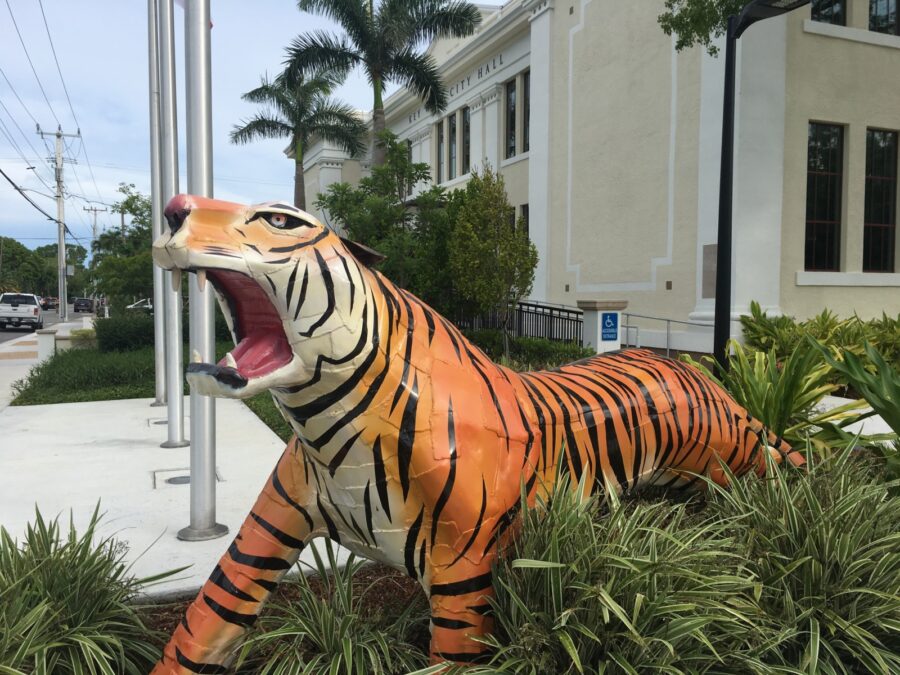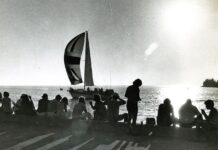
On Sept. 16, 1923 – a Sunday – a large crowd assembled in the auditorium of the new high school at 1300 White St. in Key West. The local newspaper declared it a “magnificent and commodious structure, which will now afford Monroe County such an excellent high school, taking place with the many other institutions of learning throughout the state.”
That building is now Key West’s City Hall, but its origin as an early 20th-century school built in neoclassical style is still evident.
It was used as a high school until the mid-1950s, when the high school on Flagler Avenue was built. The White Street structure became a junior high, then Glynn Archer Elementary School. In 2013, the Monroe County School District handed it over to the city (or handed it back; more on that later) and the city hall renovation began.
But it almost didn’t happen.
The city had plans to build a new City Hall at Angela and Simonton streets, on the site it had been using for decades. The concrete block building there needed replacing, and expanding. Craig Cates, current Monroe County mayor and longtime Key West mayor — had campaigned in Key West against that Angela Street plan.
Cates said it would have required more than 20 variances to fit the new structure on the old plot of land. “It would have been too much for that area,” he said. Instead, the city built a new fire station at Angela and Simonton and kept the public parking at the site.
Cates said he was happy to see such an important structure in the island’s history remain in public hands, adding that its new use is appropriate.
“Key West originally built that school,” he said. “We asked the school district, since they were done with it, could they give it back to the citizens of Key West?”
Key West in the early 1920s was in one of its many transitional periods. The 1919 hurricane had caused severe damage. The cigar industry — the island’s economic mainstay for decades — had largely moved to Tampa and been hammered by the increasing popularity of cigarettes.

And, like many communities, especially in the South, Ku Klux Klan activity and Jim Crow were ascendant. The pavilion in Bayview Park, donated by the United Daughters of the Confederacy, would be dedicated a year later. Public schools were segregated.
The new high school on White Street was built quickly – the cornerstone was laid in May 1923, and the building was dedicated just four months later. But it was built to last.
David Salay, a partner at Bender & Associates Architects, said the building was “completely original” and in great shape when he first went through it in 2013.
“I thought the city could simply use it exactly the way it was, making the classrooms into offices and renovating the interior,” he said. But the city needed its new headquarters to double as an Emergency Operations Center during hurricanes, which meant it had to meet modern structural codes. So they gutted everything but the exterior walls and gave the building a new interior. The layout was new, but they kept the historic character. “We recycled all the wood floor and wall framing and milled it into wood wainscot that you find throughout the building,” Salay said.
One element from the original layout remains – that auditorium where the crowd gathered for the dedication a century ago is now the City Commission meeting chamber. And its stage is still flanked by the historic murals painted by Works Progress Administration artists in the 1930s. They were restored while the building was under renovation.
Salay discovered some historic additions by the building’s students. “On Oct.18, 1940, two students from the class of 1941 crawled up into the attic over the auditorium and signed their names to one of the wood trusses. Their signatures from 72 years ago were still there: John Martin and Ray Pierce, Class of 1941,” Salay said. “The attic was accessed by a tiny rickety wood ladder at the side of the stage, so they must have snuck up there, as any good teenager would.”
Still intact and back in use are two “enormous” cisterns under the front building and the rear building, which was finished in 1928. The Keys pipeline bringing freshwater from the mainland wasn’t built until 1942, so cisterns were essential. The cistern under the original building is 21 by 30 feet and more than 5 feet deep. “That’s over 21,000 gallons of water,” Salay said. Both cisterns were restored and are being used for irrigation.

One addition that came well after the initial dedication in 1923 was the sculpture of the tiger out front. It is one of many school mascot sculptures made by local artist George Carey, working with his students at Key West High School.
That sculpture also has historic roots in Key West – the tiger was the mascot of Douglass School, the island’s black high school when schools were segregated. While black high school students became Key West High School Conchs in integration, many of the younger kids wound up at what became Glynn Archer Elementary – and that school adopted the tiger mascot.
The late Phyllis Allen went to Douglass High School, then became a teacher and eventually deputy superintendent of the Monroe County School District. In 2016, she told WLRN that “I get goosebumps” seeing her old school mascot still standing proud in front of a school building.
“At one point we were all segregated and now we are integrated. But yet we did not get rid of all of Douglass,” she said. And she was delighted that the tiger guards what is now City Hall.
“That shows growth for this community. That shows the kind of thinking that goes on in this community, that we can live together,” she said. “We can take the tiger from Douglass School and make it the tiger of Key West.”
nancyklingener.com
@keywestnan





















